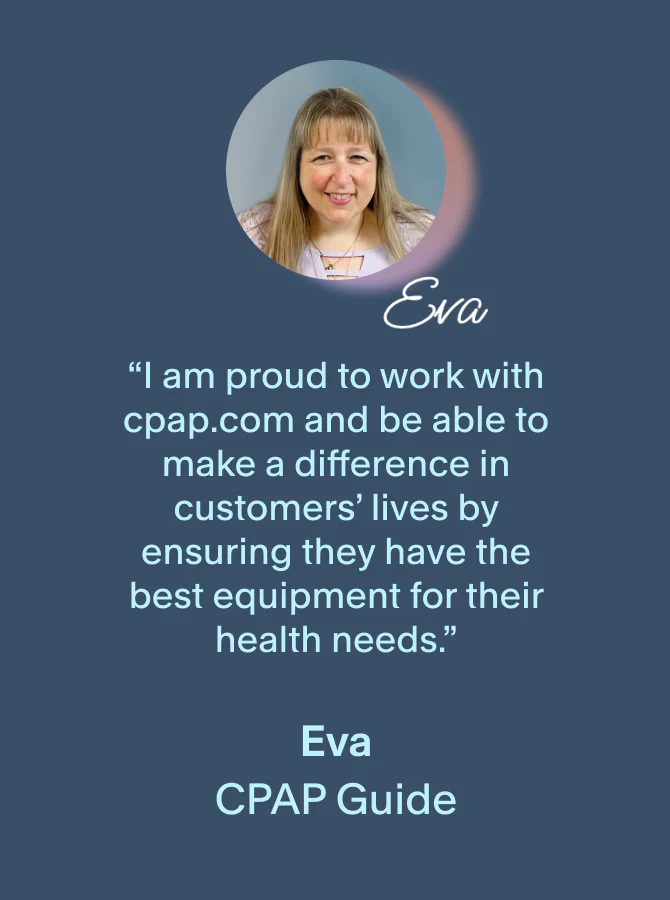Our content undergoes rigorous expert review, evidence-based research, and regular updates for accuracy.
If you’re planning a camping trip, but are worried about taking your CPAP therapy into the great outdoors, this guide to CPAP camping is for you!
💡 Key Takeaways
- Opt for Powered or Off-Grid: Choose between a campsite with electrical outlets or an off-grid experience using a CPAP battery.
- Battery Choices Matter: Deep-cycle batteries are suitable for extended trips, while CPAP-specific batteries are ideal for shorter stays.
- Conserve Battery: Using a heated humidifier will drain your battery more quickly.
- Go Portable: Opt for a travel-sized CPAP machine for both convenience and advanced features.
- Consider Solar Charging: Solar panels can recharge your CPAP battery, extending your time off-grid.
How to Power Your CPAP Machine While Camping
Not only is it possible to go camping with sleep apnea, but we’re also going to show you how you can get the most out of your experience and make your next trip a truly enjoyable one! Planning your camping trip boils down to two options when using your CPAP. You can either:
- Only Camp Where There’s an Electrical Outlet
- Take Your Therapy Off-Grid with a CPAP Battery
There are benefits and drawbacks to each, and we’ll discuss both in greater detail in the coming paragraphs. Let’s get started!
Visit a Campsite With Power
Powered campsites have the advantage of providing all the electricity you need for your therapy without as many equipment compromises. If you do a little digging, you’ll notice that there are campsites like KOA campgrounds and State Parks with electricity throughout. Being able to plug in is a huge advantage to anyone who needs CPAP humidification.
When powering your CPAP machine using battery power, you’ll find that doing so while using a heated humidifier will drain the battery at a much faster rate than it would otherwise, which dramatically reduces therapy runtime. By plugging in, you can avoid this issue and get your full therapy benefits.
Benefits: Many people like powered campsites because they’re usually clean and well-maintained. Many times they come with extra perks like bathrooms, showers, and WiFi.
Drawbacks: There are some drawbacks to powered campsites. Sometimes you’ll have to change your plans entirely because they’ll be all booked on popular weekends. They also attract a lot of people, so you won’t truly be far away from civilization and it can get noisy at certain times. If the joy of camping for you is getting far away from other people or spending the night in a rugged environment with beautiful scenery, then a campsite with electricity may not be for you. In that case, you’ll want to explore CPAP batteries.
Take Your Therapy Off-Grid
CPAP batteries allow you to go farther away from civilization, but you will be limited in how long you can be gone. Most CPAP battery packs will be good for one to two nights of power before needing to be recharged. If you plan on trekking or hiking deep into the woods or up a mountain, consider getting multiple batteries. By having two or three on hand, you can extend the time you’re away from home.
While it may be tempting to simply skip your therapy for a few nights to better enjoy the great outdoors, know that taking your therapy with you will almost certainly result in a more enjoyable trip. If you decide against packing your CPAP machine, you won’t benefit from the improved sleep and concentration, increased energy levels, and mood stability offered by successful CPAP therapy. Instead, you’ll put yourself at greater risk for high blood pressure, cardiovascular disease, stroke, and diabetes while simultaneously reducing your ability to fully enjoy your vacation. In short, packing your machine may be a hassle, but the return is well worth it and you’ll be glad you did it.
Benefits: Many camping enthusiasts see off-grid camping as the best way to go camping, and the only way to do that is with a battery. Batteries make it possible to go anywhere. Most are also FAA approved for in-flight use and will work well with popular CPAP and APAP brands.
Drawbacks: Some Lithium-ion batteries can’t handle extreme heat; it can affect chemicals found inside the battery and can lead to a fire or battery meltdown. Also, batteries are very helpful, but some can be quite expensive, costing as much as $700. However, most are in the $200 to $400 price range. Finally, depending on your machine and settings, you could run out of juice faster than expected—especially if you’re needing to use a power inverter.
Two Ways to Power Your CPAP Off-the-Grid
There are two different ways you can power your CPAP while camping off-the-grid:
- Use a Deep-Cycle Lead-Acid Battery
- Use a Portable CPAP Battery
1: Using a Deep Cycle Battery
Deep-cycle batteries are commonly found at auto parts stores as marine batteries, but can typically also be found where mobility scooters are sold. A deep-cycle battery is designed to provide continuous power over a long period of time whereas a cranking or starting battery (like you’d find in most personal vehicles) is designed to discharge a large amount of energy upfront, then be recharged by an alternator.
If weight isn’t off-putting to you, a deep-cycle battery is an efficient and cost-effective way to power your CPAP off-grid, especially if you’ll be RV camping with your CPAP.
To make it work, you’ll need to do one of two things:
- Get a DC Adapter Cable and Connect Using Your Machine’s DC Cable
- Use an Inverter
We’ll go over these points in greater detail below.
Using a DC Adapter Cable
A DC Adapter Cable uses alligator clips to connect to the positive and negative terminals of the deep-cycle battery. It then outputs the power to a cigarette lighter plug. From there, you can plug in your machine’s DC cable into the cigarette lighter plug and power your machine that way. Some deep-cycle batteries have the cigarette lighter plug built-in to the battery itself, allowing you to plug in without needing the adapter.
Using an Inverter
An inverter converts the DC power provided by the battery to AC power so your machine can use it. A few machine models require a special kind called a Pure Sine Wave Inverter. If you don’t use this inverter, you could risk damaging your machine. To make your inverter work with a car battery, you’ll need to make sure it has alligator clips that you can connect to the deep cycle battery. From there, it would convert it to AC power, and you’d plug it in as you would at home.
There are some drawbacks to using a car battery for your CPAP:
- Car Batteries Can Be Heavy: If you’ve ever replaced your car battery for your vehicle, you’d know how heavy a car battery can be. Lugging one in a backpack over long distances can be rough. Lithium-ion batteries are a lot lighter and are much easier to take with you on a long camping trip.
- Deep Cycle Batteries Are Not FAA Approved: Because deep-cycle lead-acid batteries contain toxic chemicals that can be unstable, they’re not permitted to be used on a flight or placed in checked baggage. This means you won’t be able to bring one with you while you travel by air to your destination. They also can be hard to recharge. For those that can overcome these limitations, a deep cycle battery can be a great source of power for any traveler, trekker, or camper.
2: Using a CPAP Battery Pack
Today, CPAP batteries are lighter and less expensive than they’ve ever been, and that’s a big reason why they’re becoming more popular. When it comes to batteries, one important thing to remember is that no battery is truly universal. Many batteries have DC inputs for specific machines, but if there’s no DC input, you’ll have to use an inverter.
CPAP.com makes it easy to know what power needs your particular machine has. We include this information on our product pages under the tab labeled “power.” It’s far better to connect to a battery designed to work with your specific machine than it is to pick your favorite battery and find a way to make it work.
The Best CPAP Battery for Camping
If your machine has a DC adaptor that allows you to power your machine from a 12V cigarette-lighter style socket, then you have the option of powering your unit with the best CPAP battery for camping: the EXP96 Pro. At a capacity of 307.2 Watt-Hours, with the CPAP humidifier disabled and an average pressure setting of 5-10 cm H2O, you can expect four to six full nights of CPAP therapy from a single charge.
The EXP96 Pro is a lithium-iron-phosphate battery that can handle more extreme temperatures of up to 132° F compared to the 104° F limit of standard lithium-ion batteries. It also boasts a life cycle of 5,000 recharges compared to the average 500-charge lifespan of lithium-ion batteries. While it lacks the versatility of a battery like the Portable Outlet UPS Battery, which features a standard AC outlet, the EXP96 is more energy-efficient since it uses DC power. And if that’s not good enough, it also offers an optional solar panel charger in addition to the included AC and DC chargers to keep you off-grid as long as you like. The EXP96 can even be set up between your CPAP and a wall outlet and will automatically switch to backup battery power in the event of a power failure, making it a great choice for powered campsites, too.
If, however, your machine requires AC power or doesn’t have a DC adaptor available, we recommend the Portable Outlet UPS Battery for camping with your CPAP. With its standard AC outlet, 3.0 A fast-charging USB port, and 159 Wh of capacity, the Portable Outlet UPS Battery recharges in 4-5 hours and can power your CPAP machine for one to two full nights before needing a recharge. While it doesn’t benefit from the same impressive capacity as the EXP96 Pro, the Portable Outlet is a great option for those using a powered campsite since, like the EXP96, it can be used as a backup battery.
Here’s a brief overview of some of the most popular travel machines today and portable camping batteries that work well with them:
Portable CPAP Machine Compatible CPAP Battery for Camping
Keep in mind, though, that these portable CPAP machines will only work with the EXP96 and EXP48 batteries if you have your machine-specific DC power adaptor which is not included with your machine or battery.
Related Reading: How To Choose The Best CPAP Battery Backup
3 Tips for Bringing Your CPAP Camping
Tip 1: Consider Using a Portable CPAP For Camping
If you want to go camping, it helps to have a travel-sized CPAP machine that can fit into small spaces (like a backpack) and is light enough not to add too much extra weight. This will help make it more portable, allowing you to pack more equipment than you would if you used a home unit.
Most travel CPAPs have a few distinct advantages over home units:
- You’ll Have a Machine for Home and the Road
- Travel Machines are Packed With Advanced Features Older Machines May Not Have
- You’ll Find it Easier to Use Your Machine in a Car or on a Plane
While there’s no CPAP currently available with a built-in battery, many people find that the combination of a travel machine and a travel battery works just fine.
You can also compare different portable CPAP machines by reading our complete guide on the Best Travel CPAP Machines.
The Best Portable CPAP For Camping
Opting for a travel machine is ideal for CPAP camping. Not only will it save you packing space and weight, but it will also be significantly more efficient and last much longer than a full-sized machine if you plan to run off of battery power. While you may need to sacrifice the comfort of humidification, some travel CPAP machines, like the AirMini and HDM Z2 Auto, feature waterless humidification for those that prefer it.
While the AirMini is a great option thanks to its AirSense 10-derived auto-adjusting algorithm and HumidX waterless humidification, we believe that the best portable CPAP for camping is the HDM Z2 Auto. The Z2 Auto features waterless humidification in the form of a heat-moisture exchange unit, which recirculates trapped humidity from your exhalations to prevent your mouth from drying out. At just 10.5 oz, the Z2 Auto is a great CPAP machine for backpacking as well, and you’ll save a lot more space and weight by not having to lug distilled water around with you, too.
The Z2 Auto is an exceptionally quiet portable CPAP thanks to the included QTube in-line muffler for further reducing hose noise between your mask and machine. Unlike the AirMini which uses the AirMini app on your smartphone to change settings, the Z2 features a small screen to display your pressure settings and other relevant info, making it much easier to work with while away from home. The Z2 does feature Bluetooth and a companion app to track comprehensive therapy data if you’re so inclined, and will even automatically start therapy as soon as you put your mask on and start breathing.
Rounding out the Z2’s impressive features list is the optional Z2 PowerShell with Extended Life Battery, which is a convenient way to power your Z2 Auto without an AC outlet. The PowerShell also functions as a backup battery when set up between your CPAP machine and a wall outlet and allows for easy battery changes if you have multiple Z2 Extended Life Batteries on hand.
Tip 2: Avoid Using Power Inverters
Why is using an inverter such a bad thing? Inverters rely on using battery power to do the conversion to AC. So not only is the machine drawing power from the battery, the inverter is drawing power from the battery as well. This can drain the battery twice as fast as it would if you didn’t use one. Sometimes using an inverter is unavoidable. Some machines are not DC capable, and therefore will need an AC power source, requiring a battery to be converted to AC power.
The best strategy is to find a battery that’s designed specifically for your exact machine. For example, the Pilot-24 Lite was designed with the AirMini and other 24-volt machines in mind, so it has a cable that makes a direct connection. In doing so, it doesn’t need a power inverter, and you will get a longer-lasting charge from the battery.
Tip 3: Consider Charging Your Battery With Solar
While solar charging isn’t ideal for everyone, it can be an absolute game-changer for people that often find themselves outdoors and off the grid. While there isn’t a surplus of options these days, the EXP 360 Solar Charger for EXP batteries is one of the better products available. Granted, it can be difficult to find solar charging options and they’re usually battery-specific, not universal.
Solar panels can do the work of charging the battery while you’re hiking and enjoying the great outdoors, and when you come back to camp at night, the battery will be ready for another night of therapy. Solar panels can extend your range, and help you stay in the wilderness longer.
We also have a comprehensive resource covering using solar power with CPAP batteries that may provide some helpful information you can use going forward.
Final Thoughts
As you can see, there are lots of unique ways to enjoy the great outdoors while still using your CPAP therapy. We hope you’ve learned some strategies and tricks to help make your next camping adventure a success!








